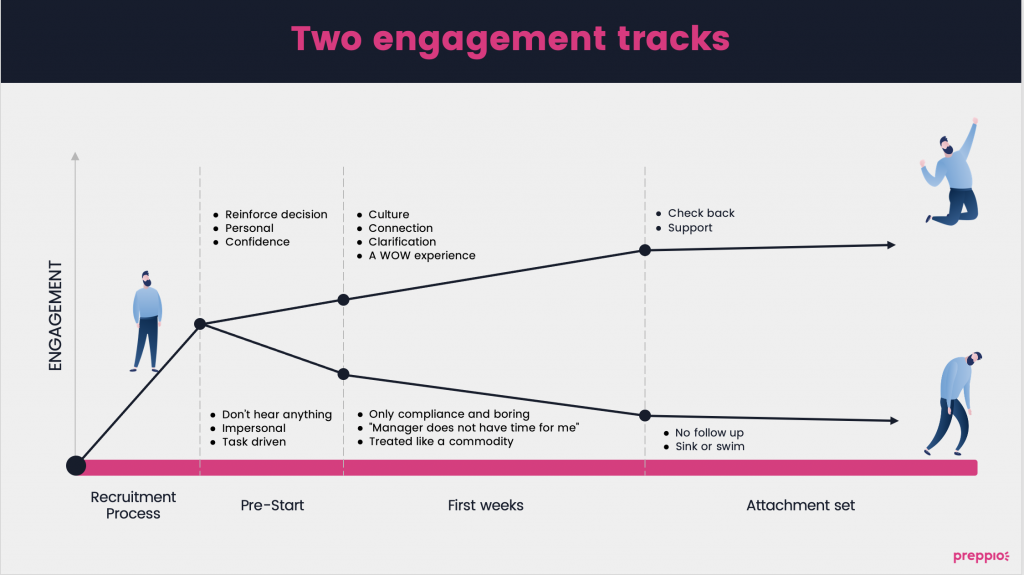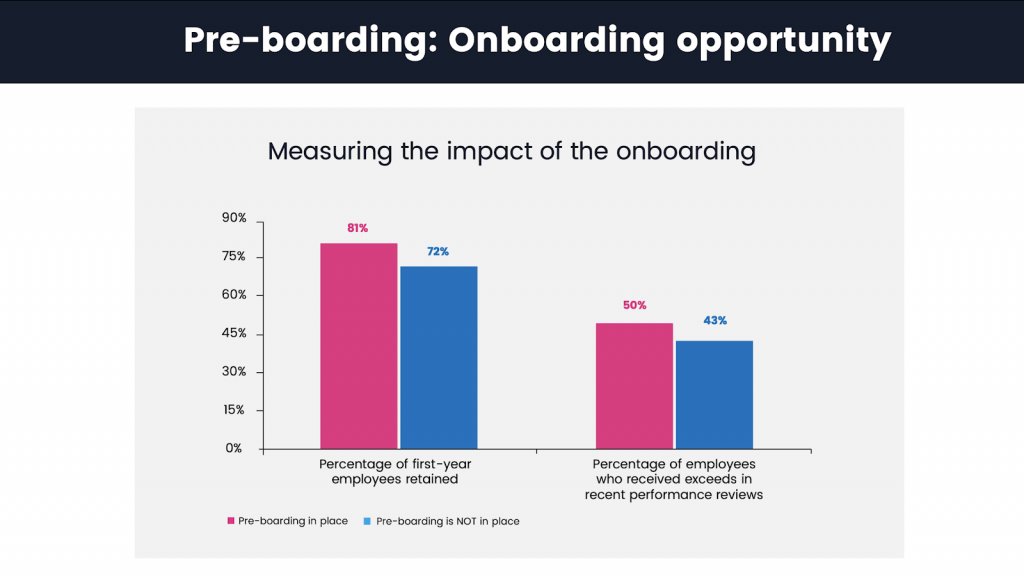Make sure your company's onboarding program is running as smoothly and effectively as possible with this helpful checklist.
It provides a clear overview of all the steps involved, so you can be certain that nothing is being overlooked or forgotten.
Introduction
I spoke to a CHRO recently and she told me about their employee preboarding process.
“We don’t want to get the fish on land just to leave it there for dead. That is how I feel about our employee preboarding process like it is today”.

In this post, I'll expand on what employee preboarding is, best practices, and provide a helpful checklist if it's new for your organization.
The nice thing is every single time a candidate accepts a job offer with your organization is an opportunity to practice and improve.
What Is Employee Preboarding?
Employee preboarding is the process of preparing new hires for their first day on the job before they even start.
This can include everything from sending them information about the company culture and values to giving them an informal tour of your workspace.
The Difference Between Pre Boarding And Onboarding
Preboarding is often confused with onboarding, but there is a difference.
Onboarding is the process of acclimating new hires after they start their job.
It's important to remember that preboarding starts the moment a candidate accepts your job offer and should continue until their first
The goal of employee preboarding is to help new hires feel engaged BEFORE their first day on the job.
Here are some examples of activities you can add to your preboarding process:
- Hand out the employee handbook
- Share your benefits guide
- Share a link to the employee introduction video
- Virtual office tour
- Information about your company's culture
- Opportunities for personal development
- Send company swag
- Seek constructive feedback about your hiring process
- What to look forward to in the new hire onboarding program
- Share an organizational chart of who's who
Here are some things to keep out of the preboarding program and save for automation after the new employee's start date:
- Tax forms
- Test employee handbook learning
- Signing forms
- Company policies
- Minor administrative tasks
This is about helping every team member feel more comfortable, confident, and excited on their first day.
That way, they can hit the ground running and be productive from day one.
The Value Of A Repeatable Preboarding Process
Investing in a repeatable preboarding process has many benefits for your organization.
A great preboarding program can help:
- Reduce new hire turnover
- Increase employee engagement
- Improve the onboarding experience
- Build a strong employer brand
If you need more help explaining the benefits, just contact Preppio. We've helped numerous organizations build a strong business case for a strong preboarding program.
A Sample Preboarding Checklist — From New Employee Accepting Offer To Their First Day
Now that we've gone over what preboarding is and the benefits of a repeatable process, let's look at a checklist you can use for each new hire.
This is based on our experience helping organizations make it more efficient.
Start
New hire accepts job offer
Send out a welcome email from the hiring manager
Add the new employee to your HRIS system
Benefits guide
Company culture video
Send calendar invites for new hires to meet their direct manager
Share the employee handbook
Confirm start date and time
Send out a welcome email from HR
Send a welcome email to notify future coworkers of new employees and how to make a great first week
Employers Often Overoptimize The Hiring Process
Here's the typical scenario in the hiring process.
Recruiters sell the job to the new hire.
The new hire feels highly valued and engaged after they have signed the contract.
Only to feel like a commodity.
Why? Because until the new employee's start date NOTHING happens.
After contracts are signed there's a lack of communication and follow-up.
How To Tell When You Need A Formal Preboarding Plan
The over-optimization above is also shown in another number you can check in your own company.
How many talent acquisition/recruiters work for every employee experience and people operations at your company?
Just like it makes no sense to only have salespeople and without a customer team, it does not make sense to just get people in without ensuring that they are set up for success.
In sales language, it leads to customer churn.
In people operation/human capital terms it leads to employee turnover.
And Underoptimize The Preboarding Process
If employees don't feel that their expectations meet reality, they are likely to lose interest quickly.
In fact when surveyed, 61% of new hires state that they do not think their new job lives up to their expectations and feel cheated. 1
When your company has invested so much in hiring a new employee, it only makes sense to not leave them feeling like dead fish after contracts are signed.
However, it’s strange that so few companies stand out from the crowd and invest more in the employee preboarding experience.
Put Yourself In The New Hire's Shoes
In the period leading up to the first day, it’s natural for employees to be a little anxious and nervous, perhaps even a little doubtful.
Same as the first day of school.
Everyone wants to feel like they’re joining a workplace that supports them and a company that looks forward to supporting them.
As part of these pre-first day jitters, employees create their own set of expectations for the new role.
They might search online to learn about the company’s staff and perhaps even make contact with future colleagues.
The days and weeks leading up to the first day is powerful.
It’s a time when we forge ideas about how starting a new job will be and try to keep our nerves under control as we wonder how we’ll perform and fit in.

Will they meet people that might become their friends?
What will the career opportunities be like?
Is there a dress code I don't know about?
What we don’t know are the untold stories about bad past work experiences, such as a difficult or ineffective manager or a dysfunctional culture that, troublingly, could also play out as a source of mild or more severe trauma.
But what if there is not a good preboarding experience before day one?
It follows that any negative feelings might be dialed right up, leaving the positive ones lagging behind.
This begs the question – why not control this and give employees what they crave?

How To Reduce The Dreaded No Show And Create Excitement
One of our clients in the airline industry struggled with employees signing a contract but never showing up for day one.
They reduced the number of employee no-shows by 75% with the following change in the process:
- After conducting surveys, the airline business in question realized that while they had a highly sophisticated system of automating communication, tasks, and training to the new hires, they’d forgotten about the employee experience.
- Their process did not drive engagement and connection in the preboarding stage as it was too focused on the tasks.
- In response, they changed the onboarding process slightly by automating two messages instructing HR or hiring managers to call the new hire to congratulate them on their new job and ask if they had any questions.
This new practice created a sense of belonging to the company and made it real that there is actually a human being, perhaps even a team, waiting for the new hire’s arrival.
This is a great example of automation actually humanizing the employee experience.
Other clients we work with have reduced no-show rates by asking new hires to add teammates on LinkedIn, listen to a podcast about the company culture (A CEO podcast episode is a good idea), or get a call from a buddy.
It Takes A Village To Onboard A New Hire Properly — Not Just The New Hire's Manager
Your whole company needs to adopt an onboarding mindset and preboarding is a critical component.
The company should not let the excitement and enthusiasm and energy of all new hires go to waste.
Creating perceptions and building actions to demonstrate that the company genuinely cares about a new hire starting requires some effort from the business’ internal stakeholders.
This is not a mindset that pats managers on the back for checking off boxes.
Rather, it’s a mindset that facilitates employee success by using tools to make it easy for all stakeholders to be onboarding champions.

The organization’s focus on its success, story, plans, and mission are great things to communicate.
But even better is creating an onboarding experience that allows the new hire to be the hero of the story.
In other words, the importance of ‘You’ in order for ‘Us’ to reach our mission.
The fact that “You were carefully selected from the vast numbers of people applying for the job, because of the fact that we believe you can help us” – is exactly how to speak to new hires.
The first days should be about giving new hires confidence, connection, clarification, culture – not information overload.
What The Research Says About Pre Boarding
In a research paper by Talya Bauer, our very own Chief Scientific Officer, competitive advantage was seen to strengthen in those organizations that capitalize on their talents.
Dr. Bauer found in one study organizations judged to be the best onboarders have a retention rate of as high as 91 percent after the first year of employment compared to just 30 percent for the organizations assessed as the worst onboarders.
Similarly, new hires who had good onboarding experiences achieved results of 71 percent for hires in the first year compared to only 17 percent for the poorest onboarders. 2
 Aberdeen Group survey 2013
Aberdeen Group survey 2013
Your Pre Boarding Program — Checklists or Pre Boarding Software?
Busy managers often forget to do the tasks on the checklist or things fall between the cracks.
If managers and people operation teams do not have a system of checks and balances in place to ensure that critical things like ordering the equipment or setting up the desk are done in time, it will lead to bad results.
It would be strange to not give the customer success department a CRM tool to ensure customers get a good onboarding experience, the same should apply for employee pre- and onboarding!

Do you have an onboarding system in place that makes sure your new hires feel cared for and set up for success when they arrive on day one?
If you struggling with heavyweight HRIS onboarding modules, spreadsheets, e-mails, or have a checklist that you hope people follow, you should consider using Preppio’s research-backed onboarding software.
It is like a CRM for your people operation teams that go beyond the checklist and create a personalized WOW experience for new hires while making the job of being a hiring manager easier!
Click here for a 30 minute demo.
